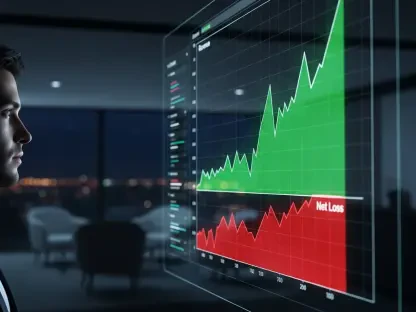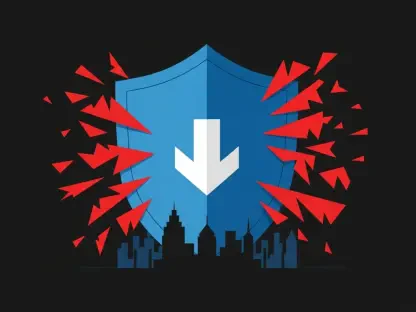The media industry today faces unprecedented risks, with a single production delay costing upwards of $250,000 per day due to an actor’s illness or an unforeseen script change, making the need for robust protection critical. As content creation spans traditional film, streaming platforms, and viral social media posts, the complexity of risks—from copyright disputes to cyber threats—has skyrocketed. This review delves into media insurance technology, a burgeoning field designed to safeguard creators and corporations alike against these dynamic challenges. By examining its core features, recent innovations, and real-world applications, this analysis aims to uncover how such technology is reshaping risk management in a fast-evolving digital landscape.
Core Features of Media Insurance Technology
Real-Time Risk Adaptation Tools
Media insurance technology stands out for its ability to adapt coverage on the fly, addressing sudden production changes like last-minute script revisions or unexpected high-risk stunts. These tools empower insurers and brokers to modify policies in real time, ensuring that protection remains relevant even under tight deadlines. Such responsiveness is critical in an industry where delays can spiral into massive financial losses, often requiring immediate adjustments to avoid project derailments.
The significance of these adaptation tools cannot be overstated, especially when considering the high stakes of media production. For instance, a single day’s delay due to a lead actor’s unavailability can disrupt budgets significantly. By enabling dynamic coverage updates, this technology minimizes downtime and maintains continuity, offering a safety net that traditional static policies often fail to provide.
Digital Risk Management Platforms
Another pivotal feature lies in platforms tailored to combat digital-specific risks, particularly for online creators such as YouTubers, podcasters, and social media influencers. These tools focus on threats like defamation and copyright infringement, which can escalate rapidly due to the viral nature of digital content. By monitoring online activity, they provide instant alerts for potential legal exposures, allowing creators to act before issues become costly lawsuits.
These platforms also play a crucial role in navigating the complexities of digital content distribution. With the ability to track a post’s reach and impact, they help insurers assess risks tied to global audiences, where a single misstep can trigger widespread backlash. This proactive approach ensures that coverage aligns with the unique challenges of the digital sphere, protecting against liabilities that traditional insurance often overlooks.
Recent Innovations in Media Insurance Tech
Advancements in media insurance technology have introduced cutting-edge tools like AI-driven risk assessment systems, which predict potential intellectual property disputes before they arise. These systems analyze content for similarities to existing works, flagging risks early and reducing the likelihood of legal battles. Additionally, cyber threat monitoring has become integral for corporate media entities, safeguarding infrastructure against data breaches and hacking attempts that could cripple operations.
Emerging trends also point toward personalized, format-specific policies catering to the diverse needs of content platforms. With streaming services and podcasts gaining prominence, insurers are crafting tailored coverage to address the distinct risks of each medium, from production delays in series to defamation claims in audio content. This shift reflects a broader move toward flexibility, ensuring that policies evolve alongside industry changes.
A notable development is the integration of machine learning to enhance risk profiling over time. By analyzing historical data and current trends, these innovations allow for more accurate pricing and coverage options, benefiting both insurers and clients. As the media landscape continues to fragment, such tools are vital for staying ahead of emerging vulnerabilities.
Real-World Applications of Media Insurance Technology
Media insurance technology serves a wide array of sectors, from traditional film and television production to digital content creators operating on platforms like YouTube and TikTok. In film, the technology provides customized coverage for high-risk stunts or unexpected delays, ensuring that multimillion-dollar projects stay on track. Meanwhile, corporate media entities rely on it to protect against infrastructural cyber risks that could compromise sensitive data.
For digital creators, the focus shifts to errors and omissions policies that address online-specific threats such as slander or copyright violations. A viral video, for example, can attract legal scrutiny overnight, making tailored protection indispensable. This versatility highlights how the technology adapts to varying scales and formats, offering solutions that match the specific demands of each creator or organization.
Beyond individual applications, this technology fosters collaboration across industries by aligning coverage with production workflows. Whether safeguarding a blockbuster movie or a small-scale podcast, it ensures that risk management integrates seamlessly into creative processes. Such adaptability underscores its value in an era where content spans countless mediums and reaches global audiences instantly.
Challenges and Limitations in Media Insurance Tech
Despite its promise, integrating advanced tools like AI and cyber risk systems into existing insurance frameworks poses significant technical hurdles. The complexity of syncing these technologies with legacy systems often leads to gaps in implementation, leaving some risks unaddressed. Additionally, legal uncertainties around intellectual property and likeness rights in the age of AI-generated content continue to complicate coverage scopes.
Regulatory and market obstacles further hinder progress, with policy exclusions for events like weather delays, pandemics, or terrorism often catching clients off guard. Securing last-minute endorsements for such risks can incur steep costs, creating financial strain for smaller productions. These limitations reveal a gap between the technology’s potential and its practical application in diverse scenarios.
Efforts to overcome these challenges include enhanced broker-client collaboration to clarify policy terms and creative intent, reducing disputes over coverage. Streamlining documentation and fostering transparency also help align expectations, ensuring that exclusions are understood upfront. While not fully resolved, these steps signal a commitment to refining the technology’s reach and reliability across the media sector.
Future Outlook for Media Insurance Technology
Looking ahead, media insurance technology is poised for transformative growth, with AI expected to enable automated policy adjustments based on real-time production data. Such advancements could streamline risk management, allowing insurers to respond instantly to shifting conditions without manual intervention. Enhanced cyber protection for media corporations also looms large, addressing the rising threat of digital attacks on infrastructure.
The long-term impact on both media and insurance industries appears profound, potentially fostering greater trust in digital content creation by mitigating legal and financial exposures. As insurers leverage technology to keep pace with rapid industry shifts, clients may gain confidence to experiment with innovative formats, knowing robust protection backs them. This synergy could redefine how risks are perceived and managed in creative spaces.
Over the next few years, from 2025 to 2027, expect a surge in format-specific solutions as platforms continue to diversify. Insurers will likely refine tools to cater to niche risks, whether tied to virtual reality content or interactive media. This evolution promises a future where coverage is as dynamic as the industry it serves, paving the way for unprecedented security in content creation.
Final Thoughts
Reflecting on this exploration of media insurance technology, it becomes evident that adaptability and real-time engagement stand as cornerstones of its success in tackling modern risks. The journey through its features, innovations, and applications revealed a toolset that has already begun transforming how creators and corporations navigate a perilous digital landscape. Its capacity to address both traditional and emerging threats marks a significant leap forward in risk management.
Moving forward, stakeholders should prioritize deeper integration of AI and cyber tools into everyday workflows, ensuring that coverage evolves alongside production demands. Collaboration between insurers, brokers, and clients must intensify to clarify exclusions and tailor policies effectively. By investing in these areas, the industry can build a resilient framework that not only protects against current challenges but also anticipates the risks of tomorrow’s media frontiers.









